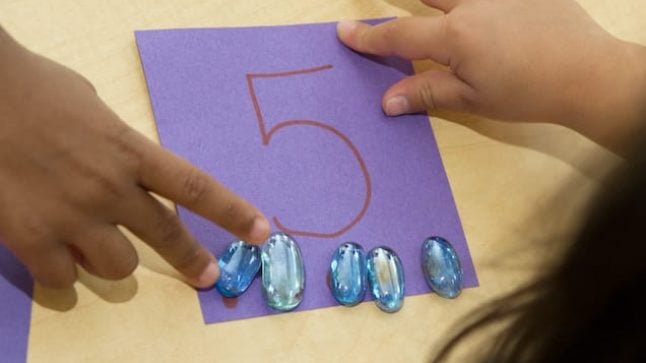Series: Focus on the Child
Why Cardinality is the Goal of Counting

What is cardinality? And how is it related to counting?
The common definition of cardinality states that it’s the understanding that the last number word said when counting tells how many in all. That is, we count a set by matching number words to objects — “1, 2, 3, 4, 5.” This procedure enumerates each object in order but does not reveal how many until we recognize, “1, 2, 3, 4, 5. That’s 5 blocks.” Now the number 5 has both an ordinal meaning (the number that comes after 4) and a cardinal meaning (the number that represents the quantity of the entire set).
Watch a kindergartner counting blocks. She is confident saying the number words in order. She matches each number to a block as she points to them. But does she understand how many blocks are on her mat?
This kindergartner clearly states the total number of blocks each time after she counts. According to the common definition of cardinality, then, we might say that she understands cardinality.
But the fact that each time a block or two is added, she goes back to counting all the blocks one by one, is significant. It is evidence that she hasn’t yet developed a full understanding of cardinality. Cardinality is more than the act of repeating the final count number. Rather it is understanding that the purpose of counting is to answer the question, “How many?” Cardinality as a concept connects the final count number to its quantity, the amount of the set.
At the same time, it is likely she also hasn’t really grasped that the number sequence is not random; it is a pattern that follows a +1 rule. Each counting number identifies a quantity that is one more than the number before it. If she did understand these concepts, then we would see her counting on from the number of blocks she knew she had. Her thinking might go something like this, “I know I had 6 blocks and you gave me 2 more so now I have 7, 8.”
See an example of counting on in this video of a kindergartner from the same class, counting the same blocks. The contrast is striking.
Both of these children are within the normal range of development in kindergarten. What’s important is that all children gain extensive experience counting in contexts where they need to know “how many.” Whether it’s at school or home, when we ask children to count, we need to give them concrete objects to count and consistently ask the question, “How many in all?” at the end of the count. In this way, we emphasize the cardinality of the set, not just the act of counting it.

Cardinality is Critical Preschool Concept with Barbara Sarnecka
After years of studying 3- and 4-year old children of diverse linguistic and cultural backgrounds, Barbara Sarnecka has zeroed in on the importance of cardinality.

How Children Learn about Numbers: A Conversation with Kelly Mix
In her presentation “Cognition and Early Childhood Numeracy: How Number Concepts are Built and Why Input Matters,” Kelly Mix bridged research and practice in her discussion of math language and learning.